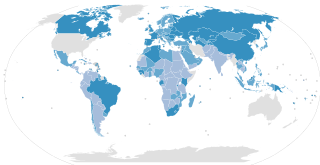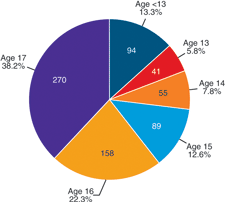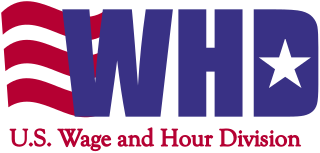Labour laws, labour code or employment laws are those that mediate the relationship between workers, employing entities, trade unions, and the government. Collective labour law relates to the tripartite relationship between employee, employer, and union.
Overtime is the amount of time someone works beyond normal working hours. The term is also used for the pay received for this time. Normal hours may be determined in several ways:
Hammer v. Dagenhart, 247 U.S. 251 (1918), was a United States Supreme Court decision in which the Court struck down a federal law regulating child labor. The decision was overruled by United States v. Darby Lumber Co. (1941).

The Equal Pay Act of 1963 is a United States labor law amending the Fair Labor Standards Act, aimed at abolishing wage disparity based on sex. It was signed into law on June 10, 1963, by John F. Kennedy as part of his New Frontier Program. In passing the bill, Congress stated that sex discrimination:

The Child Labor Amendment is a proposed and still-pending amendment to the United States Constitution that would specifically authorize Congress to regulate "labor of persons under eighteen years of age". The amendment was proposed on June 2, 1924, following Supreme Court rulings in 1918 and 1922 that federal laws regulating and taxing goods produced by employees under the ages of 14 and 16 were unconstitutional.

United States labor law sets the rights and duties for employees, labor unions, and employers in the US. Labor law's basic aim is to remedy the "inequality of bargaining power" between employees and employers, especially employers "organized in the corporate or other forms of ownership association". Over the 20th century, federal law created minimum social and economic rights, and encouraged state laws to go beyond the minimum to favor employees. The Fair Labor Standards Act of 1938 requires a federal minimum wage, currently $7.25 but higher in 29 states and D.C., and discourages working weeks over 40 hours through time-and-a-half overtime pay. There are no federal laws, and few state laws, requiring paid holidays or paid family leave. The Family and Medical Leave Act of 1993 creates a limited right to 12 weeks of unpaid leave in larger employers. There is no automatic right to an occupational pension beyond federally guaranteed Social Security, but the Employee Retirement Income Security Act of 1974 requires standards of prudent management and good governance if employers agree to provide pensions, health plans or other benefits. The Occupational Safety and Health Act of 1970 requires employees have a safe system of work.
Labor rights or workers' rights are both legal rights and human rights relating to labor relations between workers and employers. These rights are codified in national and international labor and employment law. In general, these rights influence working conditions in the relations of employment. One of the most prominent is the right to freedom of association, otherwise known as the right to organize. Workers organized in trade unions exercise the right to collective bargaining to improve working conditions.

The National Child Labor Committee (NCLC) was a private, non-profit organization in the United States that served as a leading proponent for the national child labor reform movement. Its mission was to promote "the rights, awareness, dignity, well-being and education of children and youth as they relate to work and working."
United States v. Darby Lumber Co., 312 U.S. 100 (1941), was a case in which the United States Supreme Court upheld the Fair Labor Standards Act of 1938, holding that the U.S. Congress had the power under the Commerce Clause to regulate employment conditions. The unanimous decision of the Court in this case overturned Hammer v. Dagenhart, 247 U.S. 251 (1918), limited the application of Carter v. Carter Coal Company, 298 U.S. 238 (1936), and confirmed the underlying legality of minimum wages held in West Coast Hotel Co. v. Parrish, 300 U.S. 379 (1937).
Bailey v. Drexel Furniture Co., 259 U.S. 20 (1922), was a United States Supreme Court case in which the Court ruled the 1919 Child Labor Tax Law unconstitutional as an improper attempt by Congress to penalize employers using child labor. The Court indicated that the tax imposed by the statute was actually a penalty in disguise.
National League of Cities v. Usery, 426 U.S. 833 (1976), was a case in which the Supreme Court of the United States held that the Fair Labor Standards Act could not constitutionally be applied to state governments. The decision was overruled by the U.S. Supreme Court in Garcia v. San Antonio Metropolitan Transit Authority.

The legal working age is the minimum age required by law in each country or jurisdiction for a young person who has not yet reached the age of majority to be allowed to work. Activities that are dangerous, harmful to the health or that may affect the morals or well-being of minors fall into this category.
Child labor in the United States was a common phenomenon across the economy in the 19th century. Outside agriculture, it gradually declined in the early 20th century, except in the South which added children in textile and other industries. Child labor remained common in the agricultural sector until compulsory school laws were enacted by the states. In the North state laws prohibited work in mines and later in factories. A national law was passed in 1916 but it was overturned by the Supreme Court in 1918. A 1919 law was also overturned. In the 1920s an effort to pass a constitutional amendment failed, because of opposition from the South and from Catholics. Outside of farming child labor was steadily declining in the 20th century and the New Deal in 1938 finally ended child labor in factories and mines. Child labor has always been a factor in agriculture and that continues into the 21st century.

Around the world, nearly 250 million children, about one in every six children, ages 5 through 17, are involved in child labor. Children can be found in almost any economic sector. However, at a global level, most of them work in agriculture (70%). Approximately 2.4 million adolescents aged 16 to 17 years worked in the U.S. in 2006. Official employment statistics are not available for younger adolescents who are also known to work, especially in agricultural settings.

The Fair Labor Standards Act of 1938 29 U.S.C. § 203 (FLSA) is a United States labor law that creates the right to a minimum wage, and "time-and-a-half" overtime pay when people work over forty hours a week. It also prohibits employment of minors in "oppressive child labor". It applies to employees engaged in interstate commerce or employed by an enterprise engaged in commerce or in the production of goods for commerce, unless the employer can claim an exemption from coverage. The Act was enacted by the 75th Congress and signed into law by President Franklin D. Roosevelt in 1938.
Garcia v. San Antonio Metropolitan Transit Authority, 469 U.S. 528 (1985), is a landmark United States Supreme Court decision in which the Court held that the Congress has the power under the Commerce Clause of the Constitution to extend the Fair Labor Standards Act, which requires that employers provide minimum wage and overtime pay to their employees, to state and local governments. In this case, the Court overruled its previous decision in National League of Cities v. Usery, in which the Court had held that regulation of the activities of state and local governments "in areas of traditional governmental functions" would violate the Tenth Amendment to the United States Constitution.

The history of labour law concerns the development of labour law as a way of regulating and improving the life of people at work. In the civilisations of antiquity, the use of slave labour was widespread. Some of the maladies associated with unregulated labour were identified by Pliny as "diseases of slaves."

The Harvest is a 2010 documentary film about agricultural child labor in America. The film depicts children as young as 12 years of age who work as many as 12 hours a day, six months a year, subject to hazardous conditions: heat exposure, pesticides, and dangerous work. The agriculture industry has been subject to significantly more lenient labor laws than any other occupation in the United States. As a result, lack of consistent schooling significantly limits their opportunities of succeeding in high school or more. The hazardous conditions threaten their health and lives. The purpose of the documentary is to bring awareness of the harsh working conditions which tens of thousands of children face in the fields of the United States each year and to enact the Children's Act for Responsible Employment which will bring parity of labor conditions to field workers that are afforded to minors in other occupations.

The Wage and Hour Division (WHD) of the United States Department of Labor is the federal office responsible for enforcing federal labor laws. The Division was formed with the enactment of the Fair Labor Standards Act of 1938. The Wage and Hour mission is to promote and achieve compliance with labor standards to protect and enhance the welfare of the Nation's workforce. WHD protects over 144 million workers in more than 9.8 million establishments throughout the United States and its territories. The Wage and Hour Division enforces over 13 laws, most notably the Fair Labor Standards Act and the Family Medical Leave Act. In FY18, WHD recovered $304,000,000 in back wages for over 240,000 workers and followed up FY19, with a record-breaking $322,000,000 for over 300,000 workers.
Children's Act for Responsible Employment (CARE Act) is a United States bill that would address the labor conditions of child field workers by imposing the same age, work hour, and pesticide exposure limits as other occupations and increasing the penalties for child labor violations. Representative Lucille Roybal-Allard introduced the Children's Act for Responsible Employment (CARE Act, HR 3564) bill in September 2009 and has subsequently reintroduced it.










